OODUA NATION, A structure for governance
- 18 Jul, 2022
- 7195 views
OODUA NATION
A structure for governance
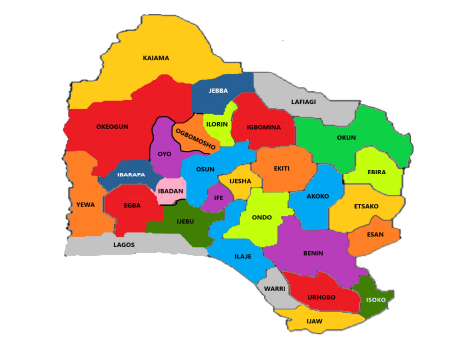
Intro
Intro The Yoruba nation is gradually waking up to the reality that we will soon be faced with the responsibility of running a country of our own. After many years of trying to work out the Nigerian project, we have now realized that we cannot achieve our potentials under the unworkable and Nigerian amalgamation.
With many processes ongoing to systematically disengage us from the Nigerian conundrum and become our own nation, not much has been said about the geographic, ethnography and governance structure for our futuristic country. This document was put together as a workable document for a possible geographic delineation, possible ethnographic configuration and a workable governance structure for a great country that is about to be born. It is not a perfect document, but something we can start with, a kind of stepping stone upon which we can build a lasting democracy when we eventually arrive at the future.
Ethnography
The term Oodua nation is used generally in this document as a spiritual expression to refer to the Yoruba speaking peoples of Nigeria of the erstwhile Oyo Empire who currently inhabits ten Nigerian states - Lagos, Oyo, Osun, Ekiti, Ondo, Ogun, Kwara, Kogi, Edo and Delta states; as well as those in the diaspora. While these states are populated by Yoruba speaking Oodua race, there are ten other ‘cousin tribes’ within these confines who speak Yoruboid languages and have Yoruboid cultures but do not consider themselves as integrals of Oodua nation.
The ten nations are:
- The Ebira of Kogi State
- The Benin of Edo state
- The Esan of Edo state
- The Etsako/Owan of Edo state
- The Urhobo of Delta state
- The Isoko of Delta state
- The Ijaw of Delta state
- The Itsekiri of Warri in Delta State
- The Baruba of Baruten & Kaiama in Kwara state
- The Nupe of Edu & Pategi in Kwara state.
The twenty Oodua divisions are
1. Lagos province
2. Egba province
3. Ijebu province
4. Yewa province
5. Ekiti province
6. Ijesha province
7. Ife province
8. Osun province
9. Oyo province
10. Ibadan province
11. Ibarapa province
12. Ogbomosho province
13. Okeogun province
14. Ilaje province
15. Akoko province
16. Ondo province
17. Ilorin province
18. Igbomina province
19. Okun province
20. Jebba provinc
These thirty different divisions, when added together, (the Cousin tribes & the Oodua divisions), forms what we will henceforth call ‘the Yoruboid Union’. Each of the cousin tribes will decide at the right time via universal suffrage whether they want to be in the union.
The Nation State
Over the years, agitators for a separate Yoruboid nationhave always used the term Oodua nation as a catalyst togalvanize us for a common purpose. No doubt, the term ishighly effective and it did unify us for a common purpose.However, should we call our new country the Republic ofOodua? Lest not forget that we will have cousins within theunion who may not share our Oodua ancestory. We shouldbe careful not to create social exclusion; we shouldtherefore choose a generic name that all tribes couldidentify with. Below is a shortlist that could be appropriate.
1. Republic of Lagosia:Since our capital is likely going to be Lagos, referringto the entire territory as Lagosia will be very generic.Lagos is a famous city worldwide; this makes it easyfor people to know where we are from. Examples ofthis are - Algeria (Algiers), Tunisia (Tunis).
2. Republic of Atlantis:This is the name of a great black civilization thatdisappeared many years ago. Since we have a longshoreline on the Atlantic Ocean, claiming the entire ocean as our own may be the first step into reclaiming our lost black civilization.
3. Union of West Africa: A union of the Oyo and Benin Empire. We have these two great West African Empires fused together. We are the first Africans the Europeans made contact with, the real West African, hence, our banging rights to be known simply as West African and our country to be known simply as Union.
4. Western Nigeria: This is the generic name of our country at independence.
The Yoruboid Flag
I have seen many different Ooduas flag designed by various wonderful Oodua groups and I must commend them for they all look absolutely splendid. However, these are Oodua flags, and can be retained for the Oodua divisions as one part of the Union.
We should also design a Generic flag for the country - for the Yoruboid Union as a whole. The other cousin tribes should be encouraged to have their own flags as well to preserve their ethnic identity within the Union. Looking at our trajectory, we started out as Oyo and Benin Empire but somehow have no flags in those days. We continued as British subjects under the British flag, after the 1894 treaty between the British and the Alafin of Oyo.
In 1960, we became a part of Nigeria after the British departed on foot of our independence from them A descriptive generic idea for a flag in such trajectory as ours will be to merge the British Union flag with the Nigerian flag to show our trajectory. Using the British Union Jack design and Nigerian colours would be a very bonafide idea. See the flags below

The light green represents the Oodua divisions whilethe deep green represents the cousin tribes.
The Provincial map

Provinces We must build a nation in which every tribe, however small will have a voice. Each linguistic division within the nation must feel safe, secured and included. The ethnic enclaves of the Yoruboid Union shows 30 clear divisions that should be respected and be allowed to metamorphose into provinces. Each province representing one tribe or dialect to ensure none is submerged in cacophony.
The 30 provinces identified were carved out of the current 10 states in the Western part of Nigeria: Lagos, Oyo, Ogun, Osun, Ondo, Ekiti, Kwara, Kogi, Edo and Delta state. Some of these states remained whole to preserve their ethnic contiguity or economic functionality. In specifics, Ekiti was left intact to preserve her ethnic contiguity while Lagos was left intact to preserve her economic functionality. The others were all broken down according to ethnic divisions.
Lagos: Lagos state will also metamorphose into Lagos Province mutatis mutandis. Lagos is a metropolitan megalopolis that can only work as one unit to ensure its global competitiveness.
Ogun, Ondo, and Edo states are broken into 3 provinces each along senatorial districts lines. These divisions correspond to approximate tribe or dialect.
Kwara is broken into five provinces to ensure that each approximate tribe and/or dialect has a voice.
Ilorin and Igbomina provinces correspond to central and eastern senatorial districts. The northern senatorial district is broken up into 3 to separate the different tribes there – the the Baruba tribe (Kaiama), The Nupe tribe (Lafiagi) and the Jebba province (Moro).
Moro is only a local government is Kwara state but a very large one, larger than most of the other provinces. It may well be the smallest province in the Union population wise but one of the biggest in terms of land size. Oyo state was broken into five provinces – Ibadan, Oyo, Ogbomosho, Ibarapa and Okeogun to enable these different divergences have separate voices. The list of local government under each province is listed for clarity.
Delta state was broken into 4 provinces along ethnic lines. – Urhobo, Itsekiri (Warri), Ijaw and Isoko.
Kogi state was broken into two provinces along the perfect lines of senatorial districts – Okun and Ebira provinces.
Osun state was broken into 3 provinces, Osun west and central senatorial districts are on one side as Osun province, since they speak same dialect, while Osun east senatorial district was broken into two – Ijesha province and Ife provinces to give them separate voices in the Union.
Provinces & capitals
This is the list of provinces and their capitals

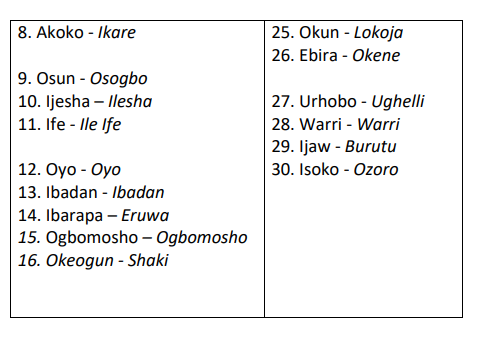
The Local Districts
There are 198 local governments under the 30 provinces as delineated. These local governments will maintain their geographic delineations but will no longer serve as local governments but as districts of the provinces.
While the provinces represent the main governing divisions within the Union, they are mostly smaller than States but bigger than local governments, ie somewhere in between. They will operate like Local Governments but have the powers of a state government and will be headed by Mayors, not Governors.
The Local Governments will no longer be local governments, or operate like local governments, they will operate differently, as districts or liaison offices of the provinces and will be headed by ‘Chief of Staff’.
Each province will have full powers to control, create or merge her districts according to her economic means, vision and developmental model.
For clarity, there are 198 local governments which will metamorphose into local districts. The identity of the districts under their provinces are provided below.
THE 198 DISTRICTS
These are the 198 districts under their different provinces

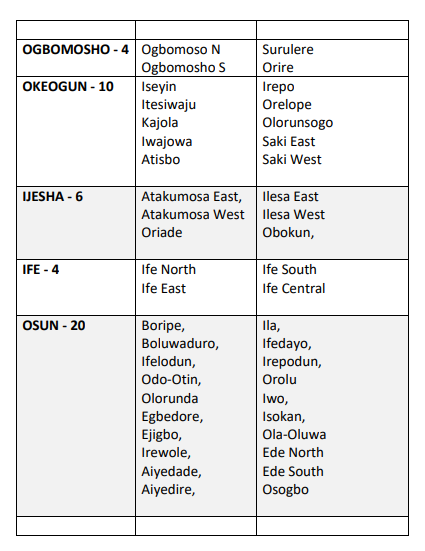
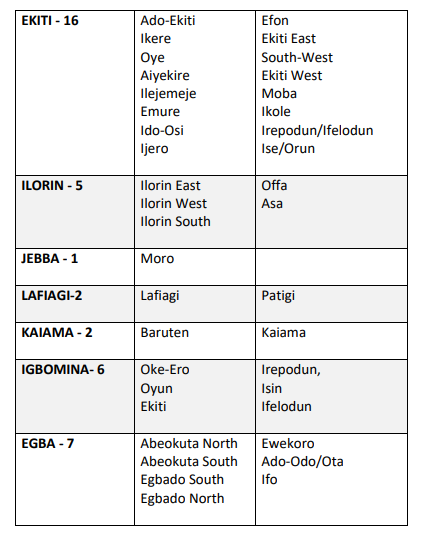

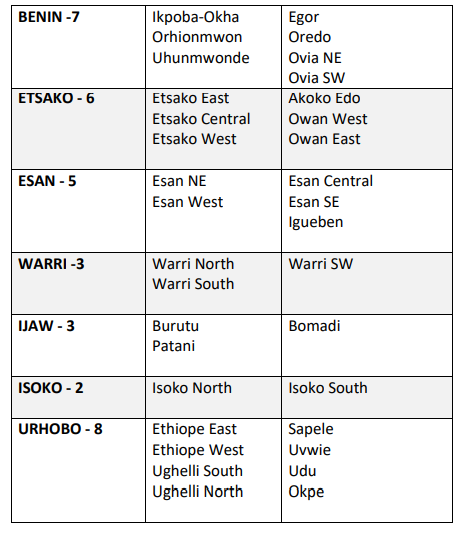
SOVEREIGNITY.
The Union shall be a representative democracy, running a parliamentary system of government, headed by a Premier. The Premier will normally be the leader of the party that won majority votes in the Parliament or the leader of the party with the largest vote in a coalition.
The Parliament will be the main legislative body and its members will be elected from different provinces according to the electoral constituencies as provided.
DERIVATION OF POWER.
The permanent head of government in principle shall be the Alafin of Oyo, the sovereign power that entered into the 1894 treaty with the British and surrendered his powers for their subsequent occupation of Oyo Empire and by extension, the Oodua Nation. This power must be restored to the Alafin. The Premier shall therefore derive his governing powers from the sovereign, in this instance the Alafin of Oyo.
For this reason, the Premier shall, upon his election, present himself before the Alafin to ask for permission to form a government. The Alafin, without prejudice, is obligated to accede to this request by temporarily transferring his powers to the Premier via a portable, staff of office.
Upon the expiration of his term, the Premier shall return to the Alafin to surrender the staff of office, same which shall be preserved for the next Premier.
PROVINCIAL SOVEREIGNS
In similar fashion, the Mayors of each province, who shall be elected by popular votes within their province shall derive their powers from the Sovereign of their province.
Each of them, upon their election into office, shall present themselves before their Sovereign to seek permission to form a government.
The Provincial Sovereign are obligated to, without prejudice accede to this request by by temporarily transferring their powers to the Premier via a written letter of proclamation.
Upon the expiration of their terms, the Mayors are not obligated to make a return trip to the sovereign but may do so on account of civility.
List of Provincial Sovereigns
1. Lagos – Oba of Lagos
2. Ekiti – Ewi of Ado Ekiti
3. Ibadan – Olubadan of Ibadan
4. Ibarapa – King of Eruwa
5. Oyo – The mayor of Oyo province is exempted from proclamation since the Alafin has already ceded his wide powers to the Premier. That should suffice.
6. Ogbomosho – Soun of Ogbomosho
7. Okeogun – Okere of Shaki
8. Osun – Ataoja of Oshogbo
9. Ijesha – Owa Obokun of Ijeshaland
10. Ife – Ooni of Ife
11. Ilorin – Oba of Ilorin
12. Okun – Oba of Lokoja
13. Jebba – Oba of Jebba
14. Lafiagi – Oba of Lafiagi
15. Kaiama – Oba of Kaiama
16. Egba – Alake of Egbaland
17. Ijebu – Awujale of Ijebuland
18. Yewa – Oba of Ilaro
19. Ondo – Deji of Akure
20. Akoko – Oba of Ikare
21. Ilaje – Oba of Okitipupa
22. Benin – Oba of Benin
23. Etsako – Oba of Auchi
24. Esan – Oba of Uromi
25. Urhobo – Oba of Ughelli
26. Warri – Olu of Warri
27. Isoko – Oba of Isoro
28. Ijaw – Oba of Burutu
29. Ebira – Oba of Okene
30. Igbomina – Oba of Ifelodun
THE PARLIAMENT
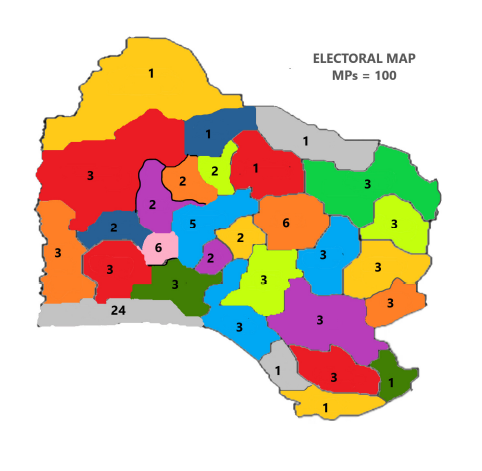
The Parliament will consist of 100 elected members, each elected from his/her constituency as delineated under the Nigerian House of Representatives constituencies.
There are 98 MPs as delineated under the Nigerian House of Representatives constituencies delineation. These delineations are preserved to give each province their electoral votes. However, two additional constituencies were created to resolve provincial issues. One each was created for Moro and Ibadan provinces.
The elected 100 members of the parliament will vote to elect a Premier, who will normally be the leader of the party with 51 or more seats in Parliament; or in a coalition, the leader of the party with the highest number of seats.
The term for a parliament shall be for five years only, after which the parliament shall be dissolved by the Premier for fresh election.
A member of parliament can serve not more than two terms of 5 years each, after which he shall not be eligible to present himself for election into the parliament again. An elected premier shall serve for a SINGLE TERM of 5 years only, after which he may continue to hold his seat in the parliament as ordinary member or elect to remove himself from public domain.
Below is the electoral chart representing the number of seats allocated to each province.
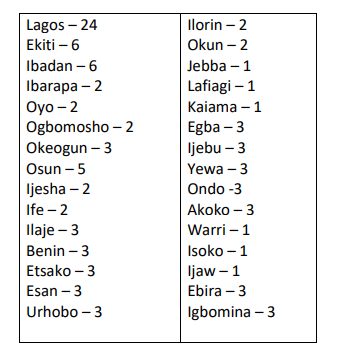
The Premier
The governmental system shall be a unitary form of government led by a Premier who will be the Leader of government business. The Premier, who is the leader of the party with most seats in parliament will form a government after being legally elected into parliament and has sought the discretion of the sovereign to form a government.
The Premier will have a kitchen cabinet of ministers, not more than 24 members maximum to help him in the everyday running of business of governance.
The ministers shall be citizens of the state who are graduates of the school of political economy to be set up.
School of Political Economy Every citizen who wants to enter into public life must attend and pass out of the school of political economy which shall be established to instruct candidates on the ethics of public life. The curriculum shall include courses in economics, basic accounting, civics, global geography, geopolitics and diplomacy. Candidatures for the 18 months course will be
1. Professors, Master’s degree holder or Graduates from a University with at least a 2-2 class.
2. An Associate of a professional body with at least five years of practice.
3. Candidates must not be of shady character, has not been investigated for fraud, arrested for any crime in their lifetime.
The essence of this school is to carefully select who gets into government in a way to ensure that only our best brains are trusted with public office.
All those who wants to participate in government in any capacity must be graduates of this school, including Mayors, MPs, ministers, etc. This does not include special advisers who may be drawn from the far and wide provided they are of good character.
Mayors
Every province will elect a Mayor to form a government and manage the business of that province for a period of 5 years. A Mayor can serve not more than a single term of 5 years only.
As the provinces are not States, they are smaller than states but bigger than local governments, just midway between the two, provinces will be run like glorified Local governments. They will not have House of Assembly or any form of elected legislature.
Provinces will run a Civil Service structure. The civil service will compose of technocrats who will normally be employed based on their own merits into the civil service.
The Secretaries or heads of the different departments of the civil service, will interface directly with the Mayor to carry out his vision during his term.
The Secretaries will form The Council that will help the Mayor govern the province. Mayors shall not sack Secretaries as they are neither elected or appointed officials but careered public servants, so they will be able to work with as many Mayors as possible until the end of their careers. Removal of a rogue Secretary must have recourse to the law courts according to the constitution in all instances.
A province may not have more than 20 Secretaries
The Districts
The districts, which are currently called local governments will not operate like local governments at all. They will have not elected officials but be run by the provincial civil service as kind of liaison offices.
Every district will be an appendage of their province, the provinces will have the powers to create more districts if they can afford it or collapse districts for economic reasons.
Civil servants will be posted from the provincial civil service to work in the district offices. It is important to ensure that indigenes of a districts are posted to work in their locality so that they can connect the people with the government.
The districts offices will be headed by Secretaries as they should be treated like a department in the civil service. 32 The idea of this is to reduce the number of politicians in the political space and increase the number of Technocrats who will be more suited for their roles.
All the civil service workers, including those in district offices will be paid according to the civil service structure.
The functions of the districts will be:
1. To generate internal revenues for their provinces
2. To find out and advise the provincial government of the areas of development needed in each district
3. To gather economic, political and security intelligence for the provinces
4. To supervise projects under construction in their domains.
- Category:
- Politics
- No comments



